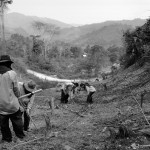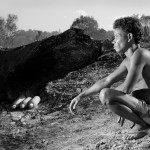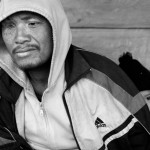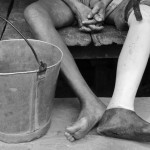Eternal Harvest: The Legacy of American Bombs in Laos
This month marks 40 years since the US withdrawal of all American troops in Vietnam. Many news outlets around the country are looking back at the end of the Vietnam War through the stories from different perspectives.
But not much attention has been given to the lasting impact of the war on neighboring Laos.
Two New Mexico journalists with years of experience living and reporting in Southeast Asia bring this issue to the attention of readers in“Eternal Harvest: The Legacy of American Bombs in Laos.”
Author Karen Coates and photographer Jerry Redfern sat down with our correspondent Gwyneth Doland to talk about the images featured in the book and the stories they heard from people in the villages of Laos.
- A farmer stands behind a live mortar he found in the field behind his home, near the Lan Som 719 battle site. A branch of the Ho Chi Minh Trail once ran through this valley, and the man says the surrounding hillsides are still covered in unexploded bombs, which makes him afraid whenever he goes out farming.
- A PCL clearance team searches a garden plot belonging to the local doctor in Sophoon. They found a BLU-3/B cluster bomb and several pounds of bomb shrapnel just below the surface.
- Workers found this bomb while digging in a quarry. Work has stopped at this part of the quarry as a clearance team waits for the proper equipment to defuse the bomb without detonating it, which would destroy the quarry.
- Harris, Yai and PCL team leader Vilaisack discuss how to detonate a 750-pound bomb found by a local woman clearing land for a garden near Sophoon.
- The lobby of the Vinh Thong Guesthouse in Phonsavan displays an amazing array of defused UXO as well as a mural depicting fighting around the Plain of Jars in 1968.
- A family weighs a cluster bomb casing at a market in Phonsavanh. Scrap metal sells by the pound.
- Children study beneath a UXO warning poster in the one-room schoolhouse in Ban Pakeo.
- Ten-year-old Bich was farming in his family’s field when something exploded. He woke up in the Phonsavanh hospital with wounds on his legs and groin and part of his jaw missing. This was his second trip to the hospital as his wounds had become re-infected.
- Tao Lee squats next to three BLU-49 fragmentation cluster bombs found in a cleared field overlooking his village in Attapeu. When the field was lit to clear it, the fire “cooked off” several other bombs. They rained shrapnel on the village in the middle of the night, forcing its temporary evacuation.
- Ta lost his eye and both his arms when a cluster bomblet he found exploded after he prodded it with a stick in 2001. He has gone through several operation since then to repair the damage, and now lives with the constant help of his seven children.
- Pae lost his leg to a landmine in 1963. His bucket is made from the aluminum tubes of American flares.
- Sou Lin Phan poses next to a large dud bomb in the middle of his village in rural Xieng Khouang Province.
(click on photos for a larger view and full descriptions)













